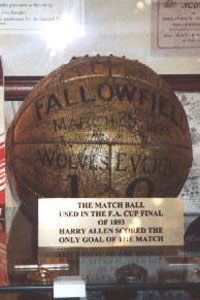
The argument over the ball at the 2010 World Cup has brought to the fore, once again, the fact that even otherwise well-informed fans don’t always know the laws of the game.
It is a myth that the modern ball is lighter than the balls used in the past.
Since 1937, the dry weight of the ball has been specified by Law 2: 14-16oz. Prior to that, the rules governing the ball’s dry weight specified something lighter – 13-15oz.
This goes for the new ball used in 2010 just as much as it did for the 1966 ball. Whenever you read a comment along the lines of “I’d like to see modern players heading the leather pudding the ’66 boys had to put up with” you can assume that they don’t know what they’re talking about.
What has changed are (1) the material from which the ball is made, and thus the ability of the ball to avoid weight gain during the game through water absorption, and (2) the aerodynamics of the ball i.e. the smoothness of the surface.
The new ball isn’t lighter in of itself – which is what people seem to be assuming: but the new ball won’t get so wet in play. So in the broad sunshine of the ’66 World Cup Final, the famous orange balls were the same weight as the ones we see today. And so it has been on every dry day, on every dry pitch, since the balls were first standardized in the early 1870s.
Lecture inspired by a comment on Alex Massie’s TNT piece here – because I wasn’t able to comment there. As usual with the sort of places Alex posts at, onerous signing-up procedures loom..
Excellent post. I’ve often wanted to make this point in blog arguments, but been too lazy to dig up the references.
It would be interesting to compile a list of things that have changed over time when kicking a ball.
Off hand : boots are lighter, with more designed kicking surface – but I don’t know of any studies of how much difference it really makes. Likewise, the new ball construction should create more energy transmission in a kick, but no idea how much difference there is.
Of course, much talk about aerodynamics, which does seem to affect some shots, but whilst it has made some keepers look foolish, my feeling is that it’s resulted in more shots off target too…
I certainly remember the weight of the wet ball when I headed it (or it headed me).
I marvel at how much easier the current ball used by my 9 year old is, compared to the one I remember from my childhood. Not too much swerve, more thud and an increasing impossibility of controlling it as the game in the rain wore on and you got more tired. Not too much aerodynamics as we got to full time.
Now the kids have a fair chance of developing some skills. I note that FIFA has accepted that there are some issues with the current ball. Also how come the Germans got to use the ball for six months prior to the World Cup?
I believe the ball was open for anyone to use before the World Cup if they so chose. The FA, money being the controlling factor in the game nowadays, have an exclusive deal with Nike (I think).
It was developed by Loughborough University, apparently. I’m quite impressed, the UK was always better at engineering than manufacture.
The England team never seemed to get to grips with this ball – I know their first touch is far worse than Spain etc. but still, I’ve never seen so many passes received and the ball pop out so far from England players as in this competition.
I’ll leave the match requiem until James posts…
Oh come off it, James. The ball was heavier because for much of the season the ball was wet, because the pitches weren’t properly drained. As I’ve told you before, in mid-season I’d never played on a decent surface, either rugby or football, until the first time I played on the stadium pitch at Murrayfield. My God, you should have tried the old rugby pitches at Canal Field. Bloody swamps.
May I suggest a game? Tell us what are the best bits of jargon you’ve picked up from the World Cup coverage. I like “the second six yard box” and “between the lines”.
Well, er… “best” is working quite hard there! R5 stalwarts aside, the World Cup coverage has been like being imprisoned within a copy of Nuts magazine. There’s one phrase – something about teams getting their battle face on or something – that the oafs have been parading as if it’s as traditional as Bobby Charlton, but it drives me to drink.
I have some – colour! – footage of the ’54 cup final – out-takes no less – that shows the ball behaving in full Jabulani style, btw (and I’ve some b&w of the same game – the psychological difference involved in watching the two clips is profound, whatever the ball is doing)
Craig Johnston (formerly of Liverpool and Adidas Predator boots) seems to feel the stats he’s compiled suggest the Jabulani isn’t just like all the other balls. I didn’t get a chance to read his letter to FIFA about it yet though.
There are rumours about NASA testing the things, too, Metatone. Just to clarify – I’m not saying that there’s no difference in the Jabulani, just that the difference isn’t down to weight. Be interesting to hear what Craig J comes up with. The NASA rumours are that the flight of the ball is genuinely unpredictable (which is why I class them as rumours – I can’t imagine NASA finding something as relatively straightforward as a Jabulani unpredictable when compared to e.g. flow mechanics and the like). N.B. I am not a physicist…